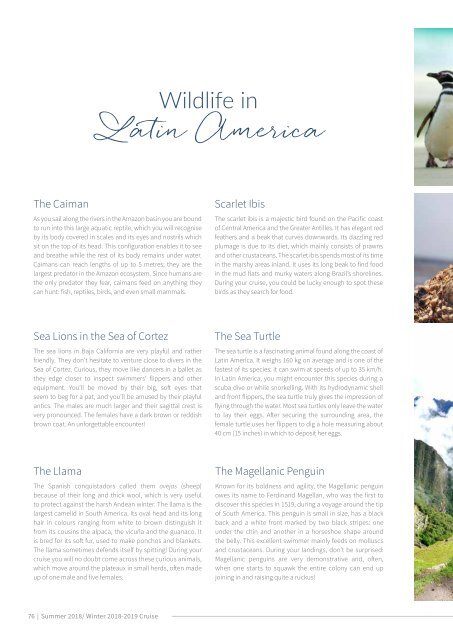LUXURY EXPEDITIONS 2018-2019
Create successful ePaper yourself
Turn your PDF publications into a flip-book with our unique Google optimized e-Paper software.
Wildlife in<br />
Latin America<br />
The Caiman<br />
As you sail along the rivers in the Amazon basin you are bound<br />
to run into this large aquatic reptile, which you will recognise<br />
by its body covered in scales and its eyes and nostrils which<br />
sit on the top of its head. This configuration enables it to see<br />
and breathe while the rest of its body remains under water.<br />
Caimans can reach lengths of up to 5 metres; they are the<br />
largest predator in the Amazon ecosystem. Since humans are<br />
the only predator they fear, caimans feed on anything they<br />
can hunt: fish, reptiles, birds, and even small mammals.<br />
Scarlet Ibis<br />
The scarlet ibis is a majestic bird found on the Pacific coast<br />
of Central America and the Greater Antilles. It has elegant red<br />
feathers and a beak that curves downwards. Its dazzling red<br />
plumage is due to its diet, which mainly consists of prawns<br />
and other crustaceans. The scarlet ibis spends most of its time<br />
in the marshy areas inland. It uses its long beak to find food<br />
in the mud flats and murky waters along Brazil’s shorelines.<br />
During your cruise, you could be lucky enough to spot these<br />
birds as they search for food.<br />
Sea Lions in the Sea of Cortez<br />
The sea lions in Baja California are very playful and rather<br />
friendly. They don’t hesitate to venture close to divers in the<br />
Sea of Cortez. Curious, they move like dancers in a ballet as<br />
they edge closer to inspect swimmers’ flippers and other<br />
equipment. You’ll be moved by their big, soft eyes that<br />
seem to beg for a pat, and you’ll be amused by their playful<br />
antics. The males are much larger and their sagittal crest is<br />
very pronounced. The females have a dark brown or reddish<br />
brown coat. An unforgettable encounter!<br />
The Sea Turtle<br />
The sea turtle is a fascinating animal found along the coast of<br />
Latin America. It weighs 160 kg on average and is one of the<br />
fastest of its species: it can swim at speeds of up to 35 km/h.<br />
In Latin America, you might encounter this species during a<br />
scuba dive or while snorkelling. With its hydrodynamic shell<br />
and front flippers, the sea turtle truly gives the impression of<br />
flying through the water. Most sea turtles only leave the water<br />
to lay their eggs. After securing the surrounding area, the<br />
female turtle uses her flippers to dig a hole measuring about<br />
40 cm (15 inches) in which to deposit her eggs.<br />
The Llama<br />
The Spanish conquistadors called them ovejas (sheep)<br />
because of their long and thick wool, which is very useful<br />
to protect against the harsh Andean winter. The llama is the<br />
largest camelid in South America. Its oval head and its long<br />
hair in colours ranging from white to brown distinguish it<br />
from its cousins the alpaca, the vicuña and the guanaco. It<br />
is bred for its soft fur, used to make ponchos and blankets.<br />
The llama sometimes defends itself by spitting! During your<br />
cruise you will no doubt come across these curious animals,<br />
which move around the plateaux in small herds, often made<br />
up of one male and five females.<br />
The Magellanic Penguin<br />
Known for its boldness and agility, the Magellanic penguin<br />
owes its name to Ferdinand Magellan, who was the first to<br />
discover this species in 1519, during a voyage around the tip<br />
of South America. This penguin is small in size, has a black<br />
back and a white front marked by two black stripes: one<br />
under the chin and another in a horseshoe shape around<br />
the belly. This excellent swimmer mainly feeds on molluscs<br />
and crustaceans. During your landings, don’t be surprised:<br />
Magellanic penguins are very demonstrative and, often,<br />
when one starts to squawk the entire colony can end up<br />
joining in and raising quite a ruckus!<br />
76 | Summer <strong>2018</strong>/ Winter <strong>2018</strong>-<strong>2019</strong> Cruise


